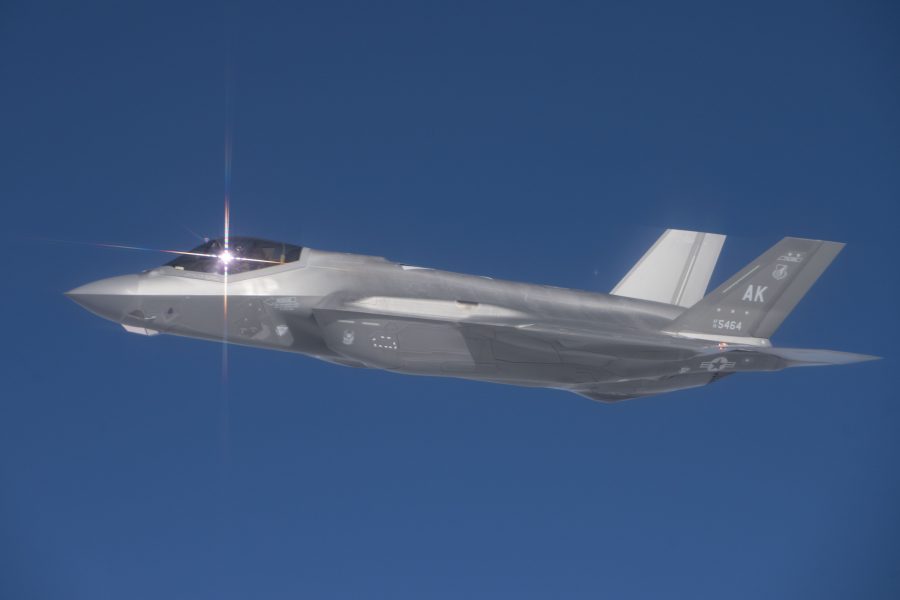Funding to build the next two batches of F-35 fighters, originally expected to be finalized by the end of June, won’t be awarded to Lockheed Martin until sometime this summer, the jet’s Joint Program Office told Air & Space Forces Magazine.
The delay is unrelated to challenges with the fighter’s new radar that are reportedly prompting the contractor to consider redesigning the jet’s fuselage, the JPO said.
With the end of the second quarter approaching, the JPO said it is “on track to definitize Lot 18-19 in summer 2025,” when it will provide more details of the agreement with Lockheed. The JPO plans to award a deal for the two lots together.
The JPO and Lockheed reached a handshake deal on Lot 18 last November, saying that a definitized contract detailing the total number of airplanes and the cost of each variant would arrive this spring.
In December, an update to an existing contract covered an additional 145 F-35s, valued at $11.8 billion, as part of Lot 18. The award included 48 F-35As for the Air Force, 16 F-35Bs and five F-35Cs for the Marine Corps, and 14 F-35Cs for the Navy. It also covered 62 F-35s for foreign militaries and support for production facilities in Italy and Japan.
The JPO said it initially planned to finalize Lot 18 first and exercise an option for Lot 19 later due to lack of funding.
“However, since Congress passed a full-year continuing resolution before finalizing Lot 18, the program can now exercise the Lot 19 option alongside Lot 18 definitization,” the office said.
A government official said that although nailing down a contract in late spring was the goal for several months, “as the teams work through the final phases of pricing and terms and conditions, it is now clear that additional time will be needed to complete the necessary DOD and [Lockheed Martin] reviews.” In the meantime, work is moving forward under the December award.
The contracting delay is “not related to radar,” the JPO said.
Lockheed has informed the Air Force that the schedule for adding a new APG-85 radar to the F-35 faces “risks,” and that the jet’s forward fuselage may be redesigned to accommodate current and future radars, Breaking Defense reported June 5. The APG-85 was supposed to be installed on F-35s slated for delivery this year as part of Lot 17.
Lockheed CEO Jim Taiclet told Air Force Chief of Staff Gen. David Allvin in a March 21 letter the company is taking steps to design a new fuselage in time for Lot 20, Breaking Defense reported. The new fuselage would work with either the F-35’s current radar, the APG-81, or the larger APG-85. Both radars were developed by Northrop Grumman.
It’s unclear whether the redesign would require more extensive testing of the stealth jet’s radar signature.
The JPO declined to comment on a possible radar delay. It told Air & Space Forces Magazine only that “the APG-85 is planned for initial fielding in Lot 17.”
The APG-85, the JPO said, “will be compatible with all variants of the F-35 aircraft” and able to defeat “current and projected adversarial air and surface threats.” It called the inclusion of the new radar “a key capability development in response to the increasing capabilities” of adversaries.
The JPO called the current APG-81 radar “already the best in the world.” It declined to comment further, citing security concerns.
Northrop announced it was working on the APG-85 in 2023. At the time, the JPO said the radar was “modernized to be the top-of-the-line radar available today, ensuring American dominance in the air.” Northrop has described it as a “multifunction sensor,” but the JPO has refused to elaborate on what that means for the F-35.
“We do not disclose technical information on operational capabilities,” the office said.
Industry officials have said, however, that new active electronically scanned array radars can function not only as sensors to detect enemy aircraft and map terrain, but can also be used for electronic warfare or even communications or cyberattacks.
F-35s are the centerpiece of the U.S. fighter fleet, used as flying supercomputers to assess the surrounding area, relay information to other forces and attack.
The program is slated to cost $2.1 trillion over nearly a century, including to purchase almost 2,500 aircraft and the costs of operating and upgrading the jets, funding related personnel, running repair depots, and foreign investment. Lockheed has delivered nearly 1,200 Joint Strike Fighters to militaries around the globe so far; 20 countries have signed onto the program.
